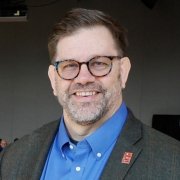Universal Design for Learning in Health Professions Education
MedEdPearls December 2021: Dr. Karl Luke’s UDL framework removes learning barriers by offering flexibility through diverse methods of representation, action, expression, and engagement.
As health professionals seek to prepare a diverse workforce, it is essential that unnecessary barriers to learning be removed. By incorporating Universal Design for Learning (UDL) principles during the curriculum development process, we can provide flexibility and allow learners to customize their learning experiences to meet their individual needs. In his article Twelve tips for Designing an Inclusive Curriculum in Medical Education Using Universal Design for Learning (UDL) Principles,
Dr. Karl Luke provides a framework for designing and implementing an inclusive curriculum based on three principles:
- Multiple means of representation: Using a variety of strategies to present information; providing a range of methods to support perception and comprehension.
- Multiple means of action and expression: Providing diverse learners with alternative ways to act competently; providing alternatives for demonstrating what learners have learned.
- Multiple means of engagement: Aligning to learners’ interests by offering choices of modality, content, and tools; optimizing relevance, value, and authenticity; motivating learners by offering variable levels of challenge and effective feedback.
Dr. Luke also suggests leveraging technology to present information in multiple forms, while stressing the importance of considering accessibility before implementing any technology. He suggests several useful techniques for including diverse voices, such as including learners in the development process and representing diverse patients in educational material. Dr. Luke articulates the value of transparency in assignments and variety in assessment. He suggests the importance of developing learning goals that encourage all learners to have equitable and flexible opportunities to develop and express knowledge and competence. In the twelfth tip, Dr. Luke provides links to UDL checklists that can be useful when contemplating UDL and deciding the UDL strategies to prioritize.
About the MedEdPearls Author

Larry Hurtubise
PhD
- Curriculum and Instruction Consultant, Michael V. Drake Institute for Teaching and Learning, Ohio State University
- Jean Bailey, PhD – Virginia Commonwealth University School of Medicine
- Carrie Bowler, EdD, MS, MLSCM (ASCP) – Mayo Clinic School of Continuous Professional Development
- Kristina Dzara, PhD, MMSc (Educators ’16; Assessment ’16; HCE 2.0 ’17) – Saint Louis University School of Medicine
- Shanu Gupta, MD, SFHM – University of South Florida Morsani College of Medicine and Tampa General Hospital
- Jennifer Hillyer, PhD – Northeast Ohio Medical University
- Larry Hurtubise, PhD, MA (HCE 2.0 '16) – The Ohio State University
- Anna Lama, EdD, MA – West Virginia University School of Medicine
- Machelle Linsenmeyer, EdD, NAOME (Assessment ’07) – West Virginia School of Osteopathic Medicine
- Skye McKennon, PharmD, BCPS, ACSM-GEI – Washington State University Elson S. Floyd College of Medicine
- Rachel Moquin, EdD, MA – Washington University School of Medicine
- Stacey Pylman, PhD – Michigan State University College of Human Medicine
- Leah Sheridan, PhD – Northeast Ohio Medical University
- Lonika Sood, MBBS, MHPE – Washington State University Elson S. Floyd College of Medicine
- Mark Terrell, EdD – Lake Erie College of Osteopathic Medicine
- Stacey Wahl, PhD – Virginia Commonwealth University School of Medicine
Harvard Macy Institute
Harvard Macy Institute
The Harvard Macy Institute educates, connects, and serves health care leaders around the globe by providing advanced faculty development programs, thought leadership, and impactful networking opportunities.
6 Programs

